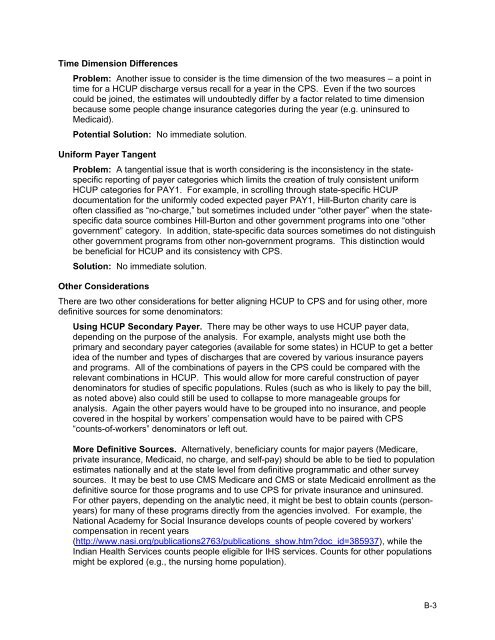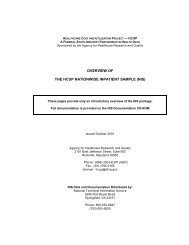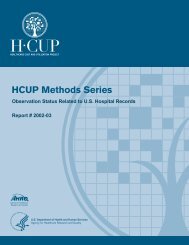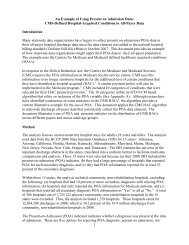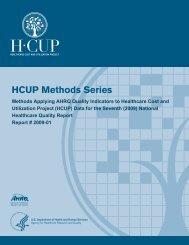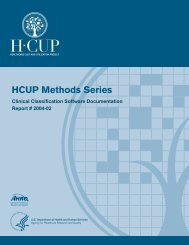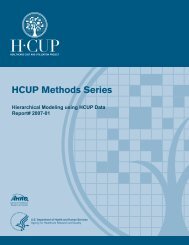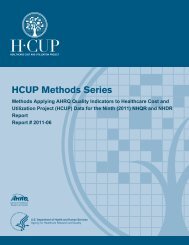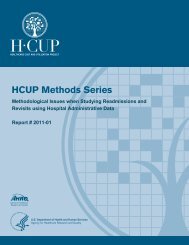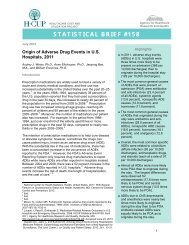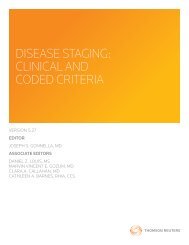Population Denominator Data for Use with the HCUP Databases
Population Denominator Data for Use with the HCUP Databases
Population Denominator Data for Use with the HCUP Databases
Create successful ePaper yourself
Turn your PDF publications into a flip-book with our unique Google optimized e-Paper software.
Time Dimension Differences<br />
Problem: Ano<strong>the</strong>r issue to consider is <strong>the</strong> time dimension of <strong>the</strong> two measures – a point in<br />
time <strong>for</strong> a <strong>HCUP</strong> discharge versus recall <strong>for</strong> a year in <strong>the</strong> CPS. Even if <strong>the</strong> two sources<br />
could be joined, <strong>the</strong> estimates will undoubtedly differ by a factor related to time dimension<br />
because some people change insurance categories during <strong>the</strong> year (e.g. uninsured to<br />
Medicaid).<br />
Potential Solution: No immediate solution.<br />
Uni<strong>for</strong>m Payer Tangent<br />
Problem: A tangential issue that is worth considering is <strong>the</strong> inconsistency in <strong>the</strong> statespecific<br />
reporting of payer categories which limits <strong>the</strong> creation of truly consistent uni<strong>for</strong>m<br />
<strong>HCUP</strong> categories <strong>for</strong> PAY1. For example, in scrolling through state-specific <strong>HCUP</strong><br />
documentation <strong>for</strong> <strong>the</strong> uni<strong>for</strong>mly coded expected payer PAY1, Hill-Burton charity care is<br />
often classified as “no-charge,” but sometimes included under “o<strong>the</strong>r payer” when <strong>the</strong> statespecific<br />
data source combines Hill-Burton and o<strong>the</strong>r government programs into one “o<strong>the</strong>r<br />
government” category. In addition, state-specific data sources sometimes do not distinguish<br />
o<strong>the</strong>r government programs from o<strong>the</strong>r non-government programs. This distinction would<br />
be beneficial <strong>for</strong> <strong>HCUP</strong> and its consistency <strong>with</strong> CPS.<br />
Solution: No immediate solution.<br />
O<strong>the</strong>r Considerations<br />
There are two o<strong>the</strong>r considerations <strong>for</strong> better aligning <strong>HCUP</strong> to CPS and <strong>for</strong> using o<strong>the</strong>r, more<br />
definitive sources <strong>for</strong> some denominators:<br />
Using <strong>HCUP</strong> Secondary Payer. There may be o<strong>the</strong>r ways to use <strong>HCUP</strong> payer data,<br />
depending on <strong>the</strong> purpose of <strong>the</strong> analysis. For example, analysts might use both <strong>the</strong><br />
primary and secondary payer categories (available <strong>for</strong> some states) in <strong>HCUP</strong> to get a better<br />
idea of <strong>the</strong> number and types of discharges that are covered by various insurance payers<br />
and programs. All of <strong>the</strong> combinations of payers in <strong>the</strong> CPS could be compared <strong>with</strong> <strong>the</strong><br />
relevant combinations in <strong>HCUP</strong>. This would allow <strong>for</strong> more careful construction of payer<br />
denominators <strong>for</strong> studies of specific populations. Rules (such as who is likely to pay <strong>the</strong> bill,<br />
as noted above) also could still be used to collapse to more manageable groups <strong>for</strong><br />
analysis. Again <strong>the</strong> o<strong>the</strong>r payers would have to be grouped into no insurance, and people<br />
covered in <strong>the</strong> hospital by workers’ compensation would have to be paired <strong>with</strong> CPS<br />
“counts-of-workers” denominators or left out.<br />
More Definitive Sources. Alternatively, beneficiary counts <strong>for</strong> major payers (Medicare,<br />
private insurance, Medicaid, no charge, and self-pay) should be able to be tied to population<br />
estimates nationally and at <strong>the</strong> state level from definitive programmatic and o<strong>the</strong>r survey<br />
sources. It may be best to use CMS Medicare and CMS or state Medicaid enrollment as <strong>the</strong><br />
definitive source <strong>for</strong> those programs and to use CPS <strong>for</strong> private insurance and uninsured.<br />
For o<strong>the</strong>r payers, depending on <strong>the</strong> analytic need, it might be best to obtain counts (personyears)<br />
<strong>for</strong> many of <strong>the</strong>se programs directly from <strong>the</strong> agencies involved. For example, <strong>the</strong><br />
National Academy <strong>for</strong> Social Insurance develops counts of people covered by workers’<br />
compensation in recent years<br />
(http://www.nasi.org/publications2763/publications_show.htm?doc_id=385937), while <strong>the</strong><br />
Indian Health Services counts people eligible <strong>for</strong> IHS services. Counts <strong>for</strong> o<strong>the</strong>r populations<br />
might be explored (e.g., <strong>the</strong> nursing home population).<br />
B-3


